Are you looking for some delicious and nutritious substitutes for buckwheat flour?
Fed up with the same old wheat-based dishes that are full of unhealthy carbs?
Buckwheat is an incredible superfood packed with vitamins and minerals that promote a healthy lifestyle – however, it may not be everyone’s cup of tea.
This blog post explores alternative flours made from various grains, nuts, seeds and legumes that can provide abundant flavor (and nutrition) to your meals – without relying on standard wheat or buckwheat options.
What Is Buckwheat Flour?
Buckwheat flour is a type of flour made from grinding buckwheat seeds into a fine powder.
It has a strong, nutty flavor and can be used to make pancakes, crepes, waffles, muffins, bread, and many other dishes.
Buckwheat is naturally gluten-free, so it’s a great alternative for those with gluten intolerance or sensitivity.
Buckwheat flour is high in protein and fiber, and has a lower glycemic index than other flour so it helps to keep blood sugar levels stable.
It’s also rich in minerals like magnesium, potassium, iron, manganese, and phosphorus.
This flour can be used as a substitute for wheat flour in many recipes.
Mixing it with other flours, such as all-purpose and whole wheat, is best, as buckwheat has a strong flavor.
When baking with buckwheat, you may need to add additional liquid or fat because the flour absorbs liquids more quickly.
You can also replace up to one-third of the regular wheat flour in a recipe with buckwheat to add flavor and nutrition.
Buckwheat is a versatile ingredient for making savory dishes like pancakes or crepes, sweet treats like muffins and cakes, hearty bread, and crunchy crackers.
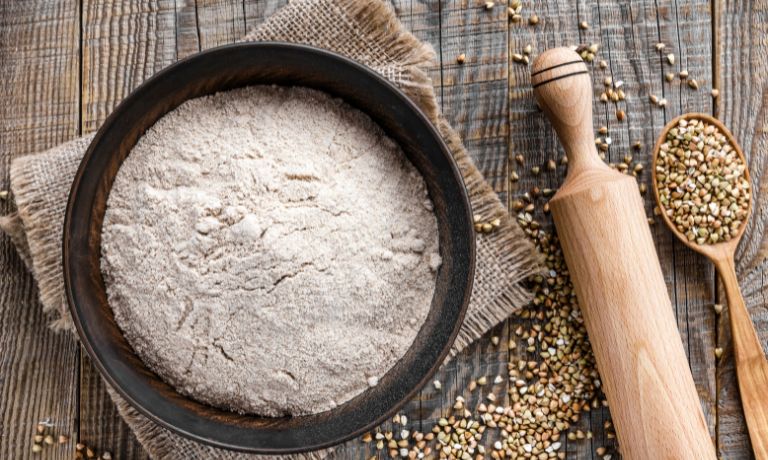
Substitutes For Buckwheat Flour
If you don’t have buckwheat flour or can’t find it in stores, there are other great alternatives that you can use.
Amaranth Flour
Amaranth flour is a type of whole-grain flour made from ground amaranth seeds.
The seeds are milled into a fine powder, making it one of the good substitutes for buckwheat flour in baking recipes.
[display-posts id=”2796″ image_size=”thumbnail” posts_per_page=”1″]
Amaranth flour has a rich, nutty flavor and maintains much of the nutritional value of the raw seed.
It is high in protein, calcium and fiber, making it an excellent choice for people looking to boost their nutrient intake.
It can also be used as a thickener or binder in recipes and has been known to add richness and complexity to baked goods such as bread, muffins and pancakes.
Because of its ability to absorb liquid differently than other flours, it is often used in gluten-free baking.
As a result, amaranth flour can be an excellent substitute for buckwheat flour that is both nutritious and versatile.

Millet Flour
Millet flour is considered one of the good substitutes for buckwheat flour. It is made from ground millet, a type of cereal grain.
It also contains essential vitamins and minerals like magnesium, phosphorus, and manganese.
Additionally, it contains fiber, protein, and carbohydrates that can add to the nutritional value of a dish.
Millet flour is also low in fat and has a low glycemic index, making it suitable for diabetics or anyone looking to control their blood sugar levels.
It’s also easy to digest compared to other grains, making it an ideal choice for those with sensitive stomachs.
Additionally, when millet flour is used in baking recipes, it can produce a light and airy texture that works well with certain pastries or cakes.
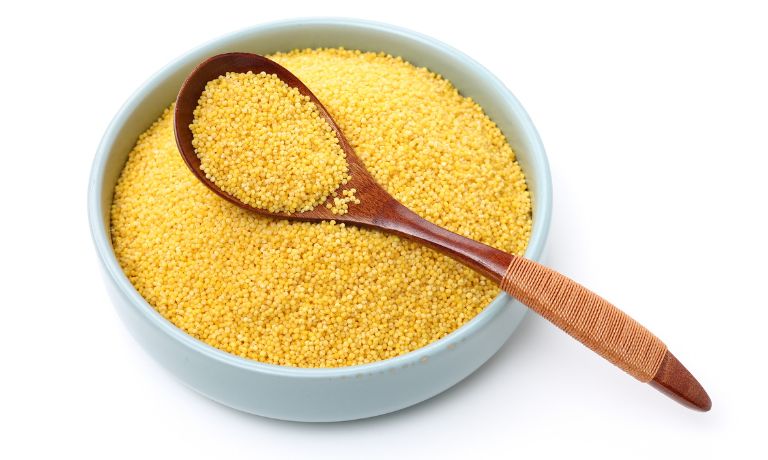
Teff Flour
Teff flour is a gluten-free whole grain flour made from the tiny teff grain native to Ethiopia and Eritrea.
It has nutty, earthy flavors perfect for baking bread, muffins, cakes, and pancakes.
[display-posts id=”2713″ image_size=”thumbnail” posts_per_page=”1″]
Teff flour also contains essential minerals like manganese, calcium, phosphorus, iron, and thiamin.
It’s high in dietary fiber and protein, making it an excellent source of nutrition.
The small size of the teff grain also makes this type of flour easier to digest than many other types.
It is one of the reasons why it can be a great substitute for buckwheat flour.
Teff flour is also less expensive than many other gluten-free flours, making it an ideal choice for those on a budget.
It lends itself well to vegan and vegetarian recipes and has a unique flavor that differentiates it from other flours.
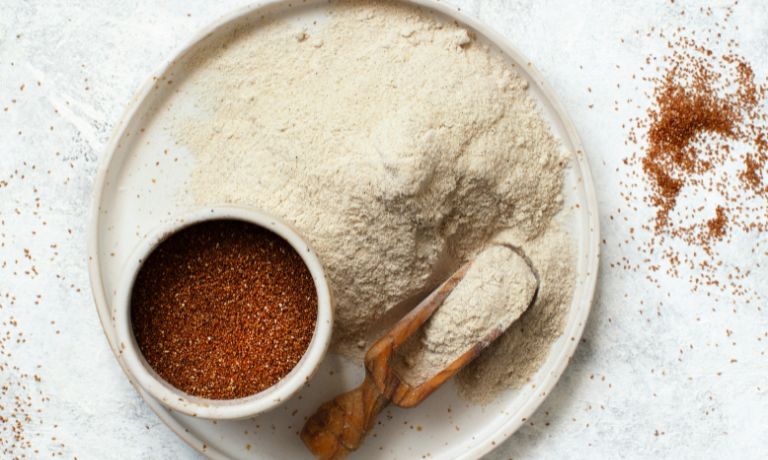
Sorghum Flour
Sorghum flour is made from 100 percent whole-grain sorghum, a highly nutritious ancient grain.
It’s gluten-free and contains plenty of fiber, protein, iron and other minerals.
Sorghum flour can be one of the best substitutes for buckwheat flour in baking recipes such as pancakes, muffins, cookies and cakes.
It has a mild flavor that does not overpower the taste of other ingredients.
It has a light texture and is easy to mix into doughs and batters.
Sorghum flour is also high in antioxidants which can help protect against inflammation and chronic diseases such as diabetes, cancer and heart disease.
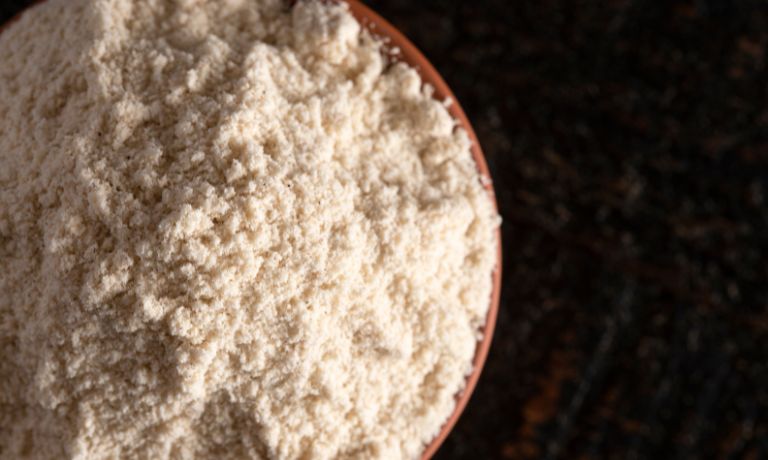
Oat Flour
Oat flour is flour made by grinding oats into a fine powder. It contains more vitamins, minerals, and fiber than other grains.
Oat flour can substitute wheat or buckwheat flour in many recipes, including cakes, cookies, muffins, pancakes, biscuits, bread, and pasta.
It has a slightly nutty taste and is a great option for baking.
[display-posts id=”2432″ image_size=”thumbnail” posts_per_page=”1″]
Oat flour is high in dietary fiber, which helps promote digestion and weight loss.
It also contains important nutrients like protein, magnesium, zinc, iron, manganese, potassium, calcium, phosphorus and B vitamins.
This means that oat flour can help boost energy, heart health, and overall well-being.
Oats also contain antioxidants which help reduce inflammation in the body.
This can be beneficial in protecting against chronic illnesses like cancer, heart disease, and diabetes.
Additionally, oat flour has a low glycemic index score so it won’t cause a spike in blood sugar levels.
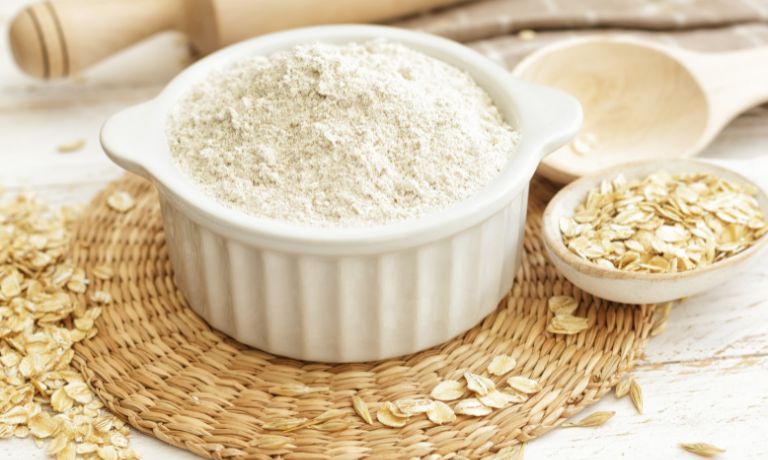
Quinoa Flour
Quinoa flour is made from ground quinoa, a protein-packed pseudocereal with a nutty flavor.
Quinoa is also rich in essential vitamins and minerals, making it one of the most nutritious gluten-free flours.
Compared to buckwheat flour, quinoa flour has a higher protein content and a milder flavor profile.
It can easily be used as a 1:1 replacement for buckwheat in most recipes – just keep an eye on the moisture levels, as quinoa flour tends to absorb more liquid than its grain-based counterpart.
Quinoa flour has a very fine texture and is easily incorporated into sweet and savory recipes, making it an incredibly versatile ingredient.
Additionally, quinoa’s nutritional profile makes it one of the best substitutes for buckwheat flour.
Try using quinoa flour in pancakes, waffles, muffins, cookies, or savory dishes like dumplings or flatbreads.
With its high nutritional content and mild flavor, quinoa flour is a great gluten-free substitute for buckwheat flour and can be used in all recipes.
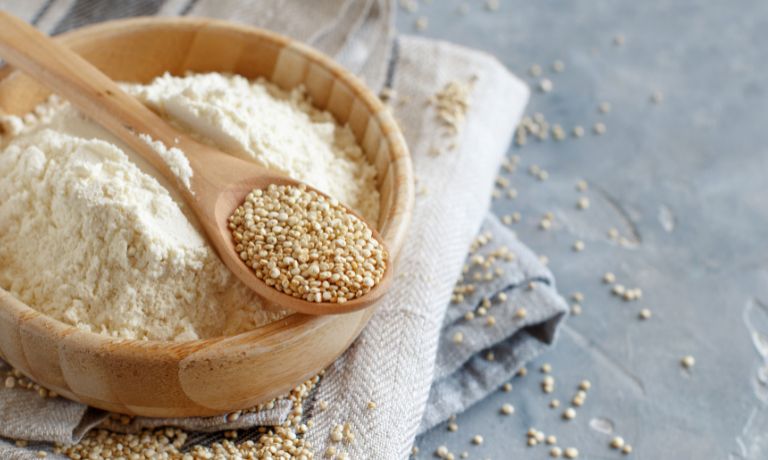
FAQs
Can Regular Flour Be Used In Place Of Buckwheat Flour?
In some cases, regular flour can be used instead of buckwheat flour, though the texture and flavor will differ.
If you’re making a cake or other baked goods with more than one type of flour, you can usually substitute up to half the total with all-purpose flour.
[display-posts id=”2341″ image_size=”thumbnail” posts_per_page=”1″]
Can Rice Flour Be Used In Place Of Buckwheat Flour?
Yes, rice flour can be used as a substitute for buckwheat flour in recipes.
Note that the flavors and textures of the two flours are quite different, so it may not be an exact substitution.
Can Almond Flour Be Used In Place Of Buckwheat Flour?
Yes, in some cases, almond flour can be used instead of buckwheat flour.
However, the texture and flavor will likely differ from when using buckwheat flour, so you may need to adjust your recipe accordingly.
Conclusion
Buckwheat flour is a great option for gluten-free baking, but it isn’t the only one.
There are many other alternatives available that can be used.
Teff flour, sorghum flour, oat flour, and quinoa flour are substitutes that provide various health benefits and unique flavor profiles that can help enhance any recipe.
When using one of these substitutes for buckwheat flour, keep an eye on moisture levels, as some flours absorb more liquid than others.
By understanding the characteristics of each flour, you can find the perfect substitute for buckwheat flour to create delicious dishes.

